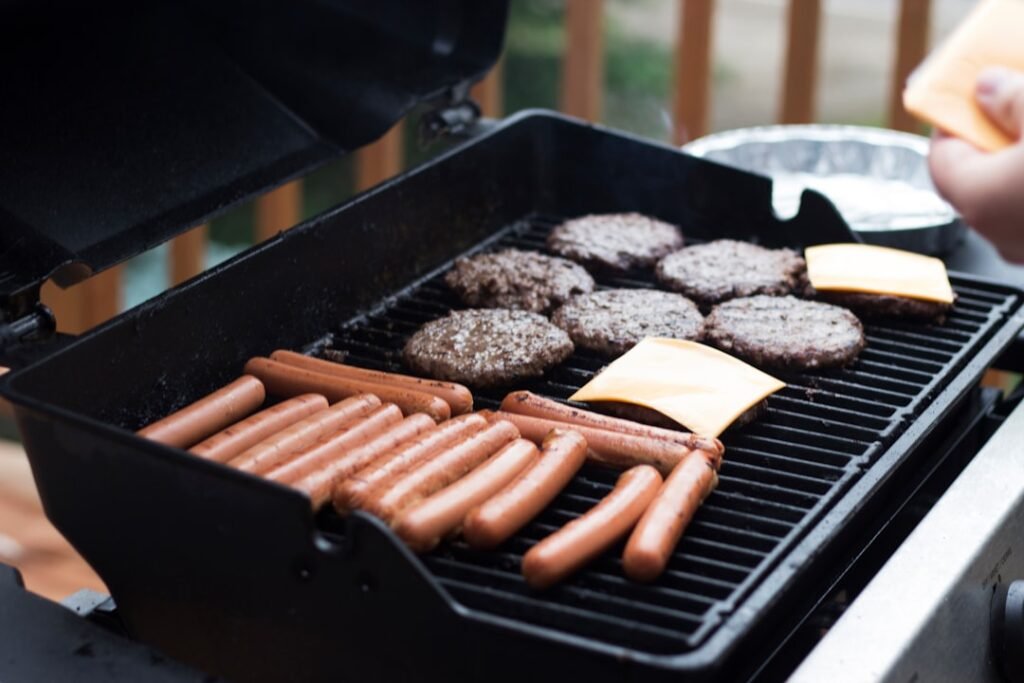Mastering BBQ Grilling: Techniques for Perfecting Your Cookout

When it comes to grilling, one of the first decisions I face is whether to choose a gas or charcoal grill. Each type has its own unique advantages and disadvantages, and my choice often depends on my personal preferences and the kind of grilling experience I seek. Gas grills are known for their convenience and ease of use.
With just the turn of a knob, I can ignite the flames and start cooking almost immediately. This is particularly appealing when I’m short on time or when I want to grill on a whim. The temperature control is also more precise, allowing me to adjust the heat quickly without having to wait for coals to reach the right temperature.
On the other hand, charcoal grills offer a distinct flavor that many enthusiasts, including myself, find hard to resist. The smoky aroma that permeates the food is something I cherish, and it’s often associated with traditional outdoor cooking. While lighting charcoal can take longer and requires a bit more effort, the end result is often worth it.
I enjoy the ritual of preparing the coals, waiting for them to ash over, and then placing my meat on the grill. The process feels more authentic and connected to the roots of grilling. Ultimately, my choice between gas and charcoal often hinges on the occasion—if I’m hosting a large gathering, I might lean towards gas for efficiency, while a quiet evening with friends might call for the rich flavors of charcoal.
Once I’ve settled on my grill type, the next step is preparing and seasoning my meat. This stage is crucial because it sets the foundation for the flavors that will develop during cooking. I always start by selecting high-quality cuts of meat, whether it’s steak, chicken, or pork.
Freshness plays a significant role in the final taste, so I make it a point to visit local markets or trusted butchers. After selecting my meat, I like to let it come to room temperature before grilling; this ensures even cooking throughout. Seasoning is where I can really get creative.
A simple sprinkle of salt and pepper can work wonders, but I often like to experiment with different marinades and rubs. For instance, a marinade made with olive oil, garlic, and herbs can infuse the meat with flavor while also tenderizing it. I usually let my meat marinate for at least an hour, but overnight is even better if time allows.
When using dry rubs, I generously coat the meat and let it sit for a while to absorb those flavors. This preparation not only enhances the taste but also builds anticipation for the delicious meal that’s about to unfold.
Mastering the Art of Temperature Control
Temperature control is one of the most critical aspects of grilling that I’ve learned to master over time. Understanding how to manage heat can mean the difference between perfectly cooked meat and a charred disaster. For gas grills, I find it relatively straightforward; I simply adjust the knobs to achieve my desired temperature.
However, with charcoal grills, things can get a bit more complex. I’ve learned that controlling airflow through the vents can significantly impact how hot the coals burn. By adjusting these vents, I can create hotter zones for searing and cooler areas for indirect cooking.
I also invest in a good meat thermometer to ensure that my meat reaches the right internal temperature without overcooking. This tool has become indispensable in my grilling arsenal. For example, when grilling chicken, I aim for an internal temperature of 165°F to ensure it’s safe to eat while remaining juicy and tender.
For steaks, I prefer medium-rare at around 135°F. By keeping an eye on these temperatures, I can confidently serve perfectly cooked dishes every time.
As I delve deeper into grilling techniques, understanding direct versus indirect grilling has become essential in my culinary repertoire. Direct grilling involves placing food directly over the heat source, which is ideal for quick-cooking items like burgers and vegetables. This method allows for that beautiful sear and caramelization that enhances flavor and texture.
When I’m in the mood for juicy burgers or grilled shrimp skewers, direct grilling is my go-to technique. Conversely, indirect grilling is perfect for larger cuts of meat that require longer cooking times, such as whole chickens or ribs. In this method, I position the food away from the direct heat source, allowing it to cook slowly and evenly.
This technique mimics roasting and helps retain moisture while developing rich flavors over time. I often use this method when preparing a whole brisket or pork shoulder; it allows me to achieve that tender fall-apart texture that’s so satisfying.
Perfecting Your Grilling Techniques: Searing, Smoking, and Rotisserie

Perfecting my grilling techniques has been an exciting journey filled with experimentation and learning from mistakes. Searing is one technique that I’ve come to appreciate deeply; it creates a flavorful crust on meats while locking in juices. To achieve a perfect sear, I preheat my grill until it’s scorching hot before placing the meat on it.
The key is not to move the meat around too much; instead, I let it sit undisturbed for a few minutes before flipping it over. Smoking is another technique that has added depth to my grilling repertoire. Using wood chips or chunks in either a gas or charcoal grill allows me to infuse my food with rich smoky flavors.
I’ve found that soaking wood chips in water before adding them to the grill helps create more smoke without burning too quickly. Whether I’m smoking ribs or salmon, this technique elevates my dishes and impresses my guests. Rotisserie grilling has also become one of my favorite methods for cooking larger cuts of meat evenly while keeping them moist.
The slow rotation allows for even cooking and basting in its own juices. Setting up a rotisserie attachment on my grill has opened up new possibilities for preparing whole chickens or even leg of lambs with minimal effort.
Utilizing Marinades, Rubs, and Sauces to Enhance Flavor
| Technique | Benefits | Considerations |
|---|---|---|
| Marinades | Enhances flavor, tenderizes meat | Requires time for marinating |
| Rubs | Adds flavor, forms a crust | Needs to be applied in advance |
| Sauces | Provides moisture, adds flavor | Can burn if applied too early |
Marinades: The Key to Moisture and Flavor
Marinades are an excellent way to infuse meats with moisture and flavor before grilling. A simple marinade made with soy sauce, honey, garlic, and ginger works wonders on chicken or pork. I often let them soak overnight to achieve maximum flavor.
Rubs: Adding Depth Without Overpowering
Rubs are another way to add depth to my grilled meats without overpowering their natural flavors. A blend of spices like paprika, cumin, brown sugar, and black pepper creates a delightful crust when grilled. I enjoy experimenting with different combinations based on what I have on hand or what flavors I’m craving at the moment.
Sauces: The Perfect Finishing Touch
Sauces are an excellent finishing touch that can take grilled dishes from good to great. Whether it’s a tangy barbecue sauce slathered on ribs or a zesty chimichurri drizzled over grilled steak, these condiments add layers of flavor that complement the smoky notes from grilling.
Tips for Grilling Vegetables and Fruits
Grilling isn’t just about meat; vegetables and fruits deserve their moment in the spotlight as well. Over time, I’ve discovered some tips that help me achieve perfectly grilled veggies and fruits that are bursting with flavor. First off, choosing seasonal produce makes a significant difference in taste; fresh ingredients always yield better results.
When grilling vegetables like bell peppers or zucchini, I often cut them into uniform pieces to ensure even cooking. A light coating of olive oil helps prevent sticking while enhancing their natural sweetness as they caramelize on the grill. For delicate items like asparagus or mushrooms, using a grill basket prevents them from falling through the grates while allowing them to absorb those delicious smoky flavors.
Fruits also shine on the grill; pineapple and peaches become incredibly sweet when caramelized over direct heat. A quick brush of honey or balsamic glaze before grilling enhances their natural sugars even further. These grilled fruits make excellent toppings for desserts or can be served alongside savory dishes for a delightful contrast.
Safety and Maintenance: Cleaning and Caring for Your Grill

Finally, safety and maintenance are crucial aspects of being a responsible griller that I never overlook. After each grilling session, I make it a point to clean my grill thoroughly; this not only ensures safety but also prolongs its lifespan. For gas grills, I turn up the heat after cooking to burn off any residue before scraping down grates with a brush.
For charcoal grills, once they’ve cooled down completely, I remove any leftover ash and debris to prevent rusting or damage over time. Regularly checking hoses and connections on gas grills is also essential for safety; ensuring there are no leaks helps prevent accidents. In addition to cleaning after each use, I perform seasonal maintenance checks where I inspect all components of my grill thoroughly—this includes checking burners for blockages or replacing worn-out parts as needed.
By taking these steps seriously, I can enjoy countless successful grilling sessions while ensuring safety for myself and my guests. In conclusion, mastering the art of grilling involves understanding various techniques and making informed choices about equipment and ingredients. From selecting between gas or charcoal grills to perfecting seasoning methods and maintaining safety standards—each aspect contributes to creating memorable meals that bring people together around the grill.






